Overt Operations: The North Korean Seizure of the USS Pueblo Exacerbates Flaws in U.S. Naval Intelligence
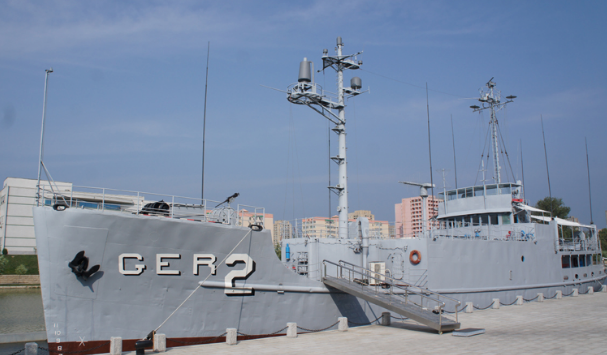
As President Trump prepares for a landmark summit meeting with Kim Jong-un, the leader of North Korea, it’s worthwhile to recall an actual landmark in that country’s capital, Pyongyang. Moored on the Potong River in the Victorious Fatherland Liberation War Museum, the USS Pueblo is still listed by the U.S. Navy as in active military service since it was seized by the North Koreans on January 23, 1968. One crew member was killed during the assault, and the 82 survivors were imprisoned and tortured by the North Koreans for nearly a year.
Even after the fall of the Soviet Union, America’s suspicions of communism and deployments against the Russians remained largely unchanged. If President Trump expects dramatic shifts in North Korean or American strategic interests to result from a single summit, history has shown that deadly games of cat-and-mouse are persistent motifs of international relations despite diplomatic initiatives to the contrary.
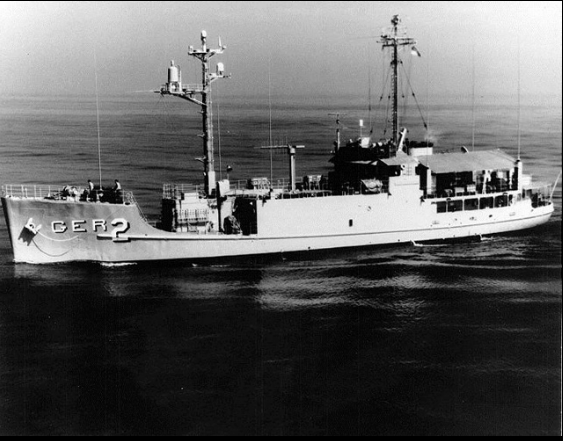
Readex’s Pravda Archive, 1959-1996: Twentieth-Century Global Perspectives allows us to examine some of the intriguing circumstances surrounding the Pueblo Incident in the continuum of naval aggression during the Cold War. This new database includes more than just the mainstream Pravda [Truth] that was the primary newspaper of the Communist Party of the Soviet Union; it also includes many regional and niche publications under related titles throughout the Eastern Bloc.
Throughout the Cold War, U.S. military vessels shadowed the coasts of Southeast Asian countries, giving rise to provocations and accidents. For example, on August 2, 1964, the destroyer USS Maddox engaged in a shootout with North Vietnamese torpedo boats during what has become known as the Gulf of Tonkin Incident. In the excerpt below from Komsomolskaya Pravda [Komsomol Truth], the correspondent observed that the American response to the Pueblo Incident had much in common with the response to the attack on the Maddox:
A U.S. destroyer, it is said in the summary of the six-month investigation, repeatedly invaded the 12 mile zone of DPRK territorial waters to reconnoiter radar and other electronic devices on the shore of a sovereign state.
The willfully organized provocation combined with the heart-rending howls of the “free” American press untied the President’s hands. Recently it became known in the United States, amid a situation of big scandal, that the plans concerning the bombings of the DRV had been worked out in Washington early in 1964. The similarity of the present events on the DPRK coast with the events in the Gulf of Tonkin in August 1964 is striking.

In 1975, the civilian container ship SS Mayaguez was seized off the coast of Cambodia. That ship was never proven to be actively involved in espionage, but its cargo did include secure containers of material removed from the U.S. Embassy in Saigon as that city was overrun by communist forces. As described in Pravda, once again the United States mounted a vigorous military response:
The intimidation by the advent of ships of the 7th Fleet was not all—bombs were dropped in the Gulf of Siam, Cambodian patrol boats were hit and sunk—the American military machinery used the fresh “opportunity” to demonstrate what it could do. In order not to let things stop with ships they also bombed Ream airport in the vicinity of the port of Kompong Som, that is, sovereign Cambodian territory. In a word, it was an act of aggression with all its appurtenances.

The USS Pueblo was built in Wisconsin in 1944 as a U.S. Army cargo ship. In 1966 it was transferred to the U.S. Navy and nominally fitted up for oceanographic research. In fact the center section visible in the photographs above housed a sophisticated array of electronic reconnaissance gear.
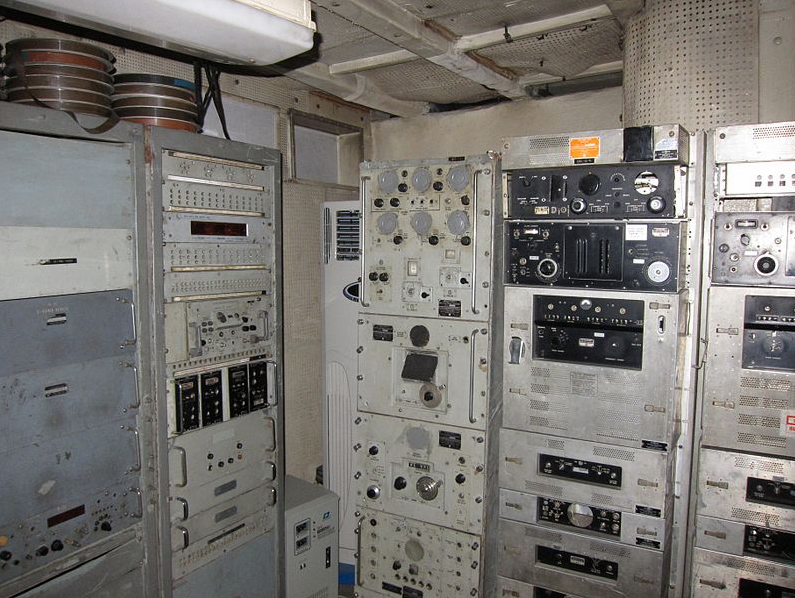
The Pueblo was armed with two .50 caliber machine guns which were unprotected, difficult to use, and not considered central to its mission of eavesdropping on North Korean communications. Unlike the Maddox, the Pueblo was unarmored; unlike the seizure of the Mayaguez, when the Pueblo was captured within territorial waters claimed by North Korea, through various lapses in communication and accountability, the ship was very much on its own. By the time the Pueblo was moored in the North Korean port of Wonsan, U.S. military action would have endangered the hostages so a stalemate ensued.
Moscow seethed with indignation at America’s perceived transgression:
The barometer of world public opinion indicates a storm. A storm of indignation at the criminal actions of the U.S. Government. Alarmed people open newspapers and listen with concern to radio commentators: what will be the next dangerous, reckless step of the men in the Pentagon who have thrown away all restraint?
There is every possible reason for alarm. You recall how this week began. There was the catastrophe of the U.S. Air Force bomber on the shores of Greenland; the cynical admission by the U.S. military authorities that the borders of Cambodia had been violated; the provocation of the spy ship Pueblo in DPRK territorial waters; a demonstration of power—the dispatch of the aircraft carrier Enterprise to the region of the North Korean port of Wonsan; and finally that atmosphere of war hysteria which has now enveloped U.S. Government institutions and which is extremely significant and dangerous.
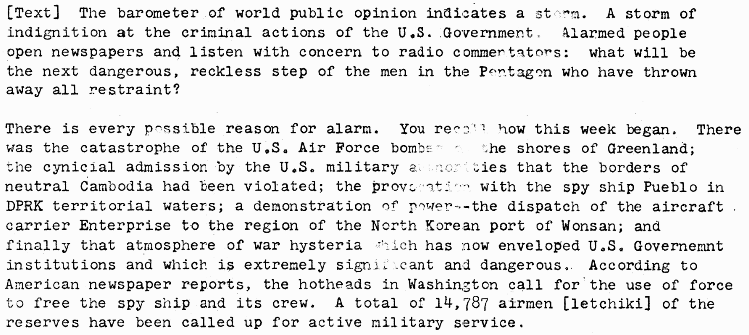
The Soviet author was correct: it had been a rough week for the American military, a week which included the crash of a B-52 in Greenland while carrying four hydrogen bombs. The Tet Offensive was about to begin in Vietnam. And America lost control of its secure naval communications when the Pueblo was ransacked for its precious surveillance equipment which included encryption machines and related intelligence material. The crew destroyed some of that gear, but for lack of time and resources a great deal remained intact for the North Koreans to recover—and share with the Soviets.
The U.S. Navy was understandably dismayed by the loss of the Pueblo and its crew, but it was thought that the intelligence equipment captured by the North Koreans would be relatively useless since the encryption keys themselves could easily be changed. What was unknown at the time was that John A. Walker, Jr., a U.S. Navy communications specialist based in Norfolk, Virginia, had begun supplying the Soviet Union with classified codes and technological information in October 1967.
In a 1995 passage from Komsomolskaya Pravda, Soviet journalist Vladimir Snegirev was interviewing American writer Peter Earley about the legacy of the spy Aldrich Ames when Walker’s name came up. Earley asserted that Walker’s spying “did far more damage” than that of Ames:
John Walker, who was recruited by your [Soviet] intelligence service, worked for the KGB from 1967 through 1985 (incidentally, I believe he did far more damage to the United States), and two weeks before his arrest you got your hooks into Ames, who “worked” for you for the next nine years. In other words, there was an unbroken chain. It is the same story with the CIA’s successes—they got Tolkachev, then Gordiyevskiy, then Polyakov....It is a continual process. Walker, who has already served 10 years of his life sentence, likes to joke that spies are very important for maintaining peace.
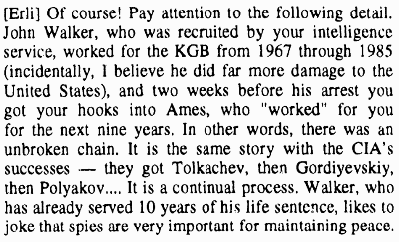
For almost two decades Walker’s treachery, combined with the physical equipment taken from the Pueblo in 1968, enabled the Soviet Union to read U.S. Navy communications soon after those messages were intercepted. Since Walker’s area of expertise was submarine warfare, the implications of this breach were especially damaging with regard to that branch of the naval service.
One possible manifestation of the cost of the Pueblo’s capture began with the loss of a Soviet submarine in the Pacific. Around March 11, 1968, the Soviets lost contact with K-129, a diesel-electric submarine carrying nuclear torpedoes and ballistic missiles. America had hydroacoustic evidence that the K-129 sank in the vicinity of Hawaii. The Soviets put forth a massive effort to find the sub but were unsuccessful.
The Americans would ultimately succeed in that endeavor and in 1976 would actually recover at least a portion of the missing submarine. America’s salvage of the sub was undertaken by Howard Hughes’ Glomar Explorer, an undersea mining ship that was purpose-built at the CIA’s request to retrieve the K-129. In just a snippet regarding the loss of the K-129, again from Komsomolskaya Pravda, we’ll note especially the fact that “people are still arguing about the causes to this day”:
No more than 10 people knew about the operation known as “Jennifer.” The project was just too improbable: Raising from a depth of half a kilometer a Soviet submarine which suffered an accident in the area of the Hawaiian Islands in April 1968. People are still arguing about the causes to this day, although most experts consider that the submarine sank as a result of an engine explosion—a highly typical “event” for submarines of this type.
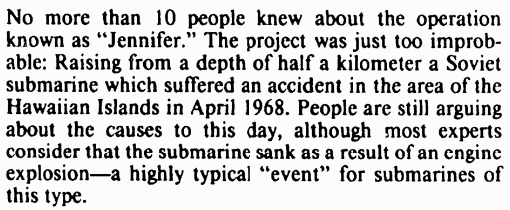
The ambiguity surrounding the loss of the K-129 left enough room for foul play. When on March 17, 1968, a U.S. attack submarine, the USS Swordfish, put in at Yokosuka, Japan, for repairs after reportedly surfacing beneath an ice floe, it was too much of a coincidence for the Soviet Union to tolerate; the U.S. was accused of intentionally ramming the missing Soviet boat and then covering up that action.
The United States soon got the opportunity to level its own charge of intentional ramming. On May 22, 1968, the U.S. nuclear attack submarine USS Scorpion was lost 400 miles southwest of the Azores. At the time it was shadowing Soviet fleet operations in the Atlantic. The Scorpion was based in Norfolk, Virginia. The spy John Walker was also based in Norfolk, and we now know that Walker was feeding specialized information about submarines to the KGB. Another coincidence? Tit for tat by the aggrieved Soviet Union?
Shortly after the Scorpion’s disappearance the Soviets expressed concern over radioactive contamination from that sub’s reactor, and affirmed that the “hand of Moscow” was suspected in the sub’s loss. They discounted this latter notion in the passage below from Pravda Ukrainy, and it’s true that some of the allegations made by the bereaved family don’t align with the sub’s known itinerary. But the Scorpion had indeed been deployed to the Mediterranean and may well have encountered a threatening Soviet ship on its way back to Norfolk. Bear in mind also that the Scorpion had not yet been found when the following was published:
As often happens in such cases there is a desire in certain circles to implicate the “hand of Moscow” here. As a result, the following absurd report from a UPI correspondent in New York appeared: In Broomall, Pennsylvania Mrs. Salvatore A. Violetti declared that on 18 May she received a letter from her son, Robert P. Violetti, in which he said that on 10 May a Soviet destroyer sailed over the Scorpion submarine and then “turned all its gun muzzles on her.” Robert P. Violetti indicated that this incident occurred near Crete in the eastern part of the Mediterranean and that American fighter planes came to “our assistance.”

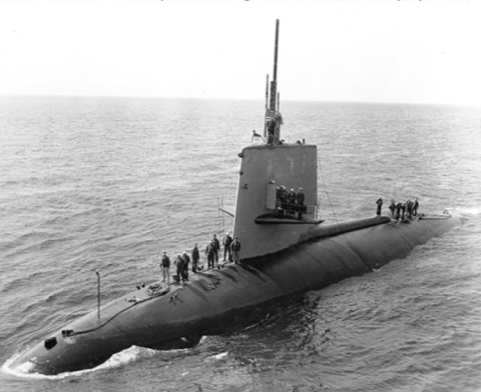
It turns out that collisions between submarines are relatively common and are considered as the cost of doing business in a highly competitive strategic arena. This is due to sonar’s inability to detect an enemy craft immediately behind a boat’s stern when underway. That blind spot encourages close pursuit by hostile subs, which in turn leads to collisions when the pursuer cannot react quickly enough to the lead boat’s changes in course. In another excerpt from Komsomolskaya Pravda relating to the operations of the USS Baton Rouge, we learn just how common submarine collisions are:
On 11 February 1992 the U.S. nuclear-powered strike submarine Baton Rouge and a CIS Joint Armed Forces nuclear-powered attack submarine collided near the entrance to Kola Bay in the Northern Fleet’s combat training area. Of course, this was a sensation to many people but not to regular submariners. In 30 years’ naval service I have repeatedly encountered, and then repaired, submarines returning from the increasingly “crowded” ocean with mangled conning towers or damaged bows. Such damage can be received only from a collision with submarines or surface ships.
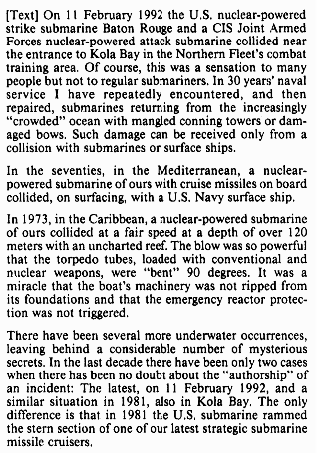
Although the incident with the USS Baton Rouge was promptly acknowledged and amicably settled, the persistent strategic focus of the United States that contributed to such encounters was called into question by the Russians, who had expected a reprieve from the Cold War based upon Mikhail Gorbachev’s transformation of the Soviet Union into the Commonwealth of Independent States (CIS):
As the recent collision between the U.S. and Russian submarines in Russian territorial waters showed, the Americans are still spying on yesterday’s potential enemy. It is a case of carry on spying despite the fact that the presidents have begun calling each other “my friend George [Bush],” and “my friend Boris [Yeltsin].” After the incident with the submarine Baton Rouge, which recently returned to base in Norfolk, Pentagon representatives have stated that they intend to keep tabs on Russia. [passage omitted]
...It seems that the principle of “trust but verify,” a principle so beloved by the Americans, has been transferred from Gorbachev to Yeltsin. And is being increasingly forgotten by us. Even though American presidents say it in Russian.
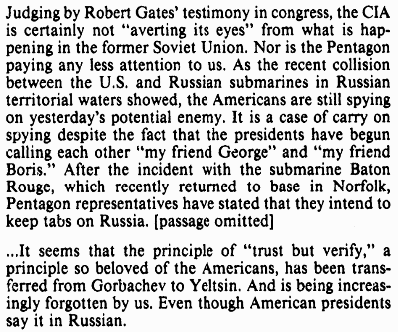
The Russians pointed out that beyond the diplomatic rhetoric, America’s stubborn proximity to the Russian coast had real-world security implications:
The settlement of disputes about whether the collision occurred in Russian territorial waters or whether these are neutral waters, as the Americans claim, can be left to the politicians. But it should not be forgotten here that less than 50 km separated the Baton Rouge from where it lay “in ambush” and our shore. While the range of a Tomahawk tactical missile is 2,500 km, to say nothing about the 23 submarines equipped with Poseidon and Trident ballistic missiles, in whose homing heads the coordinates for targets on the territory of the former Union remain the same as before.

Large, strategic missile submarines require considerable room when changing course. Similarly, the ship of state is also unwieldy, and doesn’t always respond to the helm in real time. Although President Trump’s talks with North Korea are encouraging, until the Korean Peninsula is peacefully reunited, the communist Juche [self-reliance] ideal stands in the way of a meaningful rapprochement. Since Kim Jung-un’s regime is founded upon that very ideal, it may be a long time before Americans, whether diplomats or tourists, get to set foot upon the deck of the USS Pueblo.
For more information about Readex’s Pravda Archive, 1959-1996: Twentieth-Century Global Perspectives, please contact Readex Marketing.



